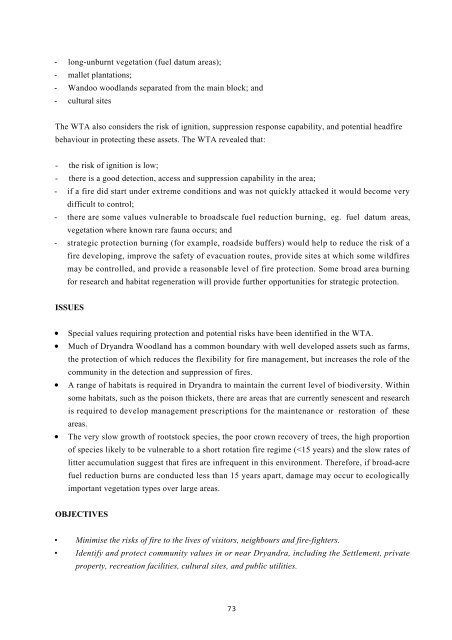Dryandra Woodland - Department of Environment and Conservation ...
Dryandra Woodland - Department of Environment and Conservation ...
Dryandra Woodland - Department of Environment and Conservation ...
You also want an ePaper? Increase the reach of your titles
YUMPU automatically turns print PDFs into web optimized ePapers that Google loves.
- long-unburnt vegetation (fuel datum areas);<br />
- mallet plantations;<br />
- W<strong>and</strong>oo woodl<strong>and</strong>s separated from the main block; <strong>and</strong><br />
- cultural sites<br />
The WTA also considers the risk <strong>of</strong> ignition, suppression response capability, <strong>and</strong> potential headfire<br />
behaviour in protecting these assets. The WTA revealed that:<br />
- the risk <strong>of</strong> ignition is low;<br />
- there is a good detection, access <strong>and</strong> suppression capability in the area;<br />
- if a fire did start under extreme conditions <strong>and</strong> was not quickly attacked it would become very<br />
difficult to control;<br />
- there are some values vulnerable to broadscale fuel reduction burning, eg. fuel datum areas,<br />
vegetation where known rare fauna occurs; <strong>and</strong><br />
- strategic protection burning (for example, roadside buffers) would help to reduce the risk <strong>of</strong> a<br />
fire developing, improve the safety <strong>of</strong> evacuation routes, provide sites at which some wildfires<br />
may be controlled, <strong>and</strong> provide a reasonable level <strong>of</strong> fire protection. Some broad area burning<br />
for research <strong>and</strong> habitat regeneration will provide further opportunities for strategic protection.<br />
ISSUES<br />
• Special values requiring protection <strong>and</strong> potential risks have been identified in the WTA.<br />
• Much <strong>of</strong> <strong>Dry<strong>and</strong>ra</strong> <strong>Woodl<strong>and</strong></strong> has a common boundary with well developed assets such as farms,<br />
the protection <strong>of</strong> which reduces the flexibility for fire management, but increases the role <strong>of</strong> the<br />
community in the detection <strong>and</strong> suppression <strong>of</strong> fires.<br />
• A range <strong>of</strong> habitats is required in <strong>Dry<strong>and</strong>ra</strong> to maintain the current level <strong>of</strong> biodiversity. Within<br />
some habitats, such as the poison thickets, there are areas that are currently senescent <strong>and</strong> research<br />
is required to develop management prescriptions for the maintenance or restoration <strong>of</strong> these<br />
areas.<br />
• The very slow growth <strong>of</strong> rootstock species, the poor crown recovery <strong>of</strong> trees, the high proportion<br />
<strong>of</strong> species likely to be vulnerable to a short rotation fire regime (

















